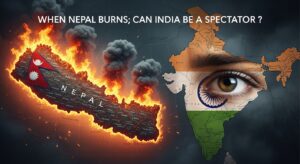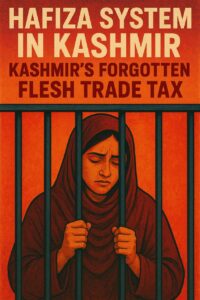Will India’s Leaders Act Before Our Youth Follow Nepal’s Playbook?

Nepal’s parliament burned while India’s 100 million unemployed youth watched and learned. The same inequality statistics. The same elite disconnect. The same generational rage. Now Indian policymakers face a terrifying question: will our streets be next to witness democracy’s violent collapse?
When dreams die, nations burn and across India’s tea stalls, college campuses, and unemployment queues, millions of young eyes are fixed on the flames rising from Kathmandu. The sound of breaking glass in Nepal’s parliament should haunt every Indian policymaker’s sleepless night, because our youth are watching, learning, and quietly calculating their own breaking point. When young Nepali voices rose in unified rage, chanting ” Neta ka bachcha gaadi mein, gaadi pahunchi khaadi mein”, they weren’t just protesting a social media ban. They were screaming the death of hope itself, a generation’s collective realization that their dreams had been auctioned to the highest bidder while their futures were shipped overseas as cheap labour. Alongside cries of “Shut down corruption and not social media,” “Unban social media,” and “Youths against corruption,” these weren’t merely slogans but the desperate gasps of democracy drowning in inequality. Today, as smoke still rises from Nepal’s parliament buildings and at least 30 young lives have been claimed by state violence, India stares into the same abyss. The terrifying truth? Our numbers are exponentially worse, our inequalities mirror theirs with mathematical precision, and our youth over 100 million strong, face the same suffocating reality that pushed Nepal’s Generation Z beyond their breaking point.
The Nepal Catastrophe: When Economic Desperation Meets Political Betrayal
Nepal’s recent Gen Z-led uprising that toppled Prime Minister K.P. Sharma Oli wasn’t just about a social media ban. Anger had been brewing for years about the country’s worsening youth unemployment crisis and lack of economic opportunities, exacerbated by what many viewed as a growing disparity between the country’s elite and regular people. The numbers paint a grim picture: 20% youth unemployment with the average Nepali making US$1,400 per year, while families of the country’s ruling elite displayed their wealth on social media.
This wasn’t merely economic frustration; it was a generational rupture. 33% of Nepalese GDP comes from remittances with hundreds of thousands of exit permits being issued, indicating that Nepal’s economy has essentially become a labour export machine rather than a generator of domestic opportunity. The social media ban became “the last straw” because it severed the digital lifelines that young Nepalis relied on for both economic survival and social connection.
The scale of violence that followed, setting fire to the Supreme Court, parliament and other government buildings demonstrates what happens when economic desperation meets political alienation. By September 9 at least 22 protesters were dead, the parliament building and other government offices were in flames, marking one of the most dramatic governmental collapses in South Asian recent history.
India’s Reckoning: The Perfect Storm of Inequality and Political Opportunism
The research note’s comparative analysis reveals an uncomfortable truth: India’s inequality metrics mirror Nepal’s with frightening precision. Both nations exhibit extreme wealth concentration where the top 1% controls over 40% of total wealth, while income distribution remains severely skewed with the top 10% capturing more than half of national income.
However, India’s situation contains several factors that could make potential unrest even more devastating than Nepal’s experience. While Nepal’s youth unemployment stands at approximately 20%, India’s youth unemployment has consistently hovered around similar levels, affecting a population base that is exponentially larger. The absolute numbers are staggering, where Nepal’s crisis involves roughly 6 million young people, India’s equivalent demographic encompasses over 100 million individuals.
More critically, India’s wealth inequality exhibits what economists call “hyper-globalized concentration.” Unlike Nepal’s domestically-focused elite wealth in banking and real estate, India’s ultra-wealthy hold significant stakes in technology, pharmaceuticals, and multinational conglomerates. This creates a psychological distance between the elite and common citizens that can be more inflammatory than Nepal’s visible but smaller-scale inequality.
Several concerning parallels emerge when examining the structural drivers of inequality in both nations. Caste and ethnic hierarchies continue to predict economic disadvantage with mathematical precision. In both countries, marginalized communities remain statistically over-represented among the poor, creating intersectional grievances that combine economic frustration with historical injustice.
The nature of employment opportunities presents another red flag. Nepal’s economy pushed young people into remittance-dependent overseas work or online gig economy participation. India faces similar challenges where formal sector job creation has lagged behind economic growth, forcing millions into precarious informal employment or digital platform work without social security.
Perhaps most dangerously, both countries exhibit what sociologists’ term “visible inequality”, a phenomenon where social media and digital connectivity make wealth disparities more psychologically painful for those excluded. The “Nepo kids” phenomenon that catalysed Nepal’s protests where elite families flaunted luxury while citizens struggled, has direct parallels in India’s social media landscape.
The research data suggests that India’s marginally lower top 1% income share (22-23% versus Nepal’s 26.5%) provides little comfort when considering the absolute scale of deprivation. India’s bottom 50% receives only 13% of national income compared to Nepal’s 19%, indicating potentially deeper systemic exclusion despite recent economic growth.
Indian policymakers must recognize that Nepal’s crisis represents more than isolated political instability. The crisis echoed recent youth-led uprisings in Sri Lanka (2022) and Bangladesh (2024), underscoring the fragility of small South Asian democracies, but India’s size and complexity could make similar unrest exponentially more destructive.
Complicating this landscape further is India’s fractured political environment, where multiple opposition parties actively seek opportunities to destabilize the ruling government. These political forces, driven by electoral calculations rather than genuine concern for inequality, view any signs of economic discontent as potential weapons for political mobilization. The combination of legitimate grievances and opportunistic politics creates a volatile mixture where genuine economic protests can quickly be hijacked and escalated beyond their original scope.
This political opportunism means that government machinery cannot afford to treat any signs of unrest as routine law-and-order issues. What begins as localized economic protests can rapidly transform into nationwide political movements when opposition parties sense vulnerability. The government must therefore adopt a dual strategy: addressing the root economic causes while remaining vigilant against political exploitation of legitimate grievances.
The solution requires moving beyond traditional poverty alleviation toward what economists’ call “inclusive growth architecture.” This means creating employment-first economic policies rather than GDP-growth-first approaches, addressing structural discrimination that perpetuates caste and ethnic economic disadvantages, and developing wealth distribution mechanisms that prevent hyper-concentration among the ultra-elite. Nothing can be taken for granted at this critical juncture.
Nepal’s Gen Z protesters didn’t just demand governmental change, they rejected the entire democratic framework when it failed to deliver economic opportunity. India’s policymakers have a narrow window to prevent similar institutional collapse by addressing the structural inequalities that make such uprisings inevitable. The data doesn’t lie: when hope dies among the young, democracies follow.
Across India today, from the chai shops of Mumbai to the engineering colleges of Bangalore, young voices are discussing Nepal’s uprising in hushed, knowing tones. They see themselves in those Kathmandu protesters, the same unemployment statistics, the same elite disconnect, the same crushing realization that the system wasn’t built for them.
When dreams die, nations burn, and India’s youth are watching Nepal’s flames with a mixture of sympathy and strategic interest. The question isn’t whether India will face similar pressures, but whether its leaders will learn from Nepal’s crisis before our own youth decide that burning it all down is the only path to rebuilding it right


